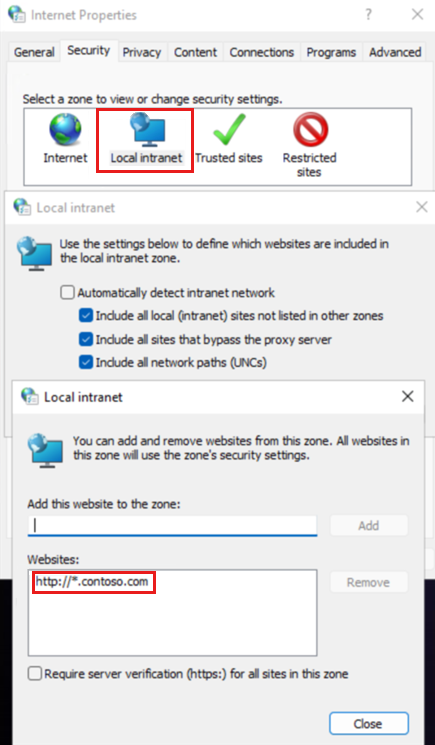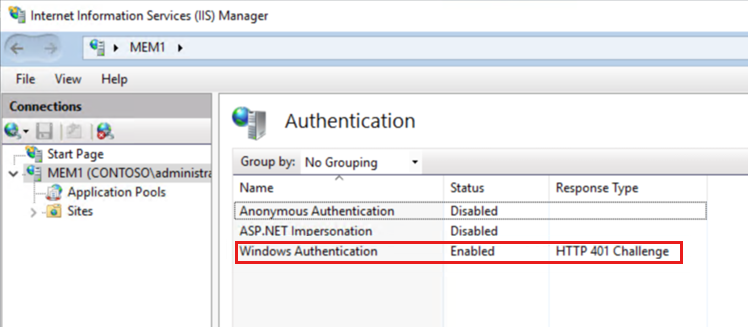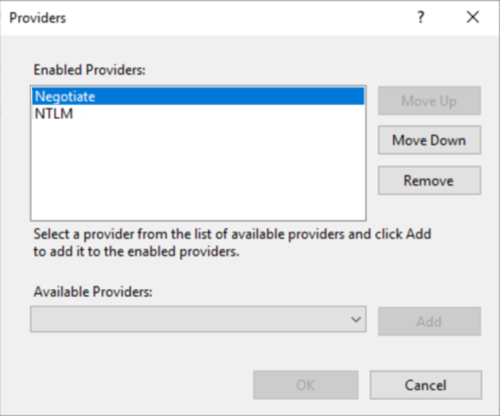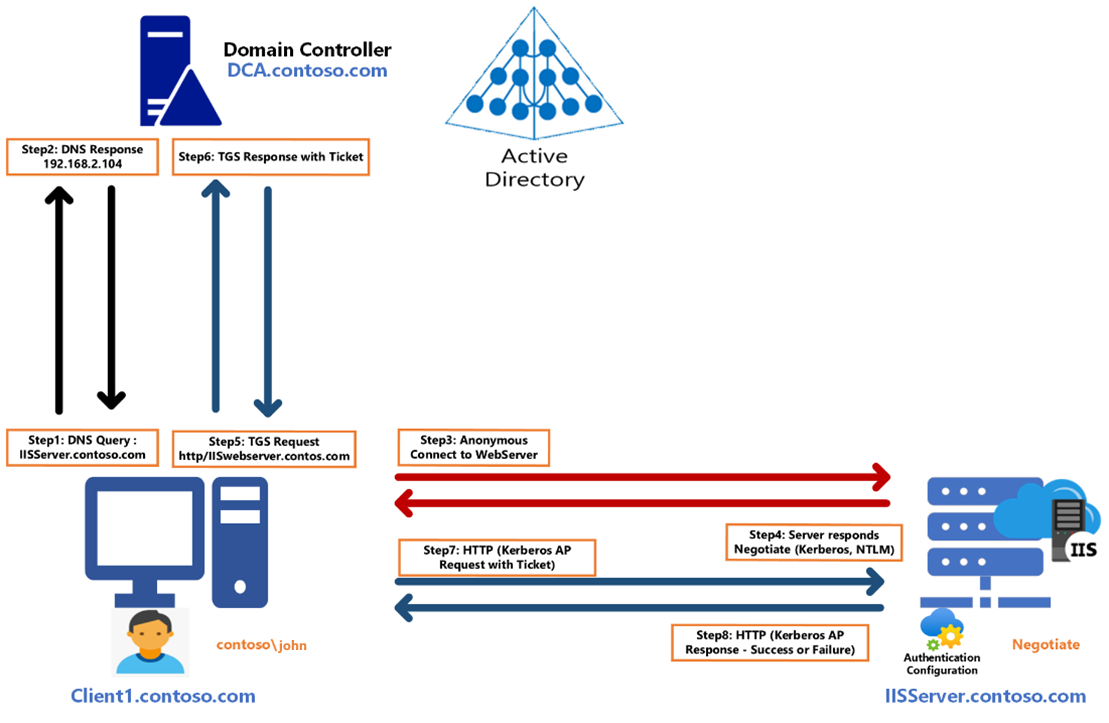Kerberos authentication troubleshooting guidance
This guide provides you with the fundamental concepts used when troubleshooting Kerberos authentication issues.
Troubleshooting checklist
A Kerberos-related error is a symptom of another service failing. The Kerberos protocol relies on many services that must be available and functioning properly for any authentication to take place.
To determine whether a problem is occurring with Kerberos authentication, check the System event log for errors from any services by filtering it using the "source" (such as Kerberos, kdc, LsaSrv, or Netlogon) on the client, target server, or domain controller that provide authentication. If any such errors exist, there might be errors associated with the Kerberos protocol as well.
Failure audits on the target server's Security event log might show that the Kerberos protocol was being used when a logon failure occurred.
Before you inspect the Kerberos protocol, make sure that the following services or conditions are functioning properly:
- The network infrastructure is functioning properly, and all computers and services can communicate.
- The domain controller is accessible. You can run the command
nltest /dsgetdc:<Domain Name> /force /kdc(for example,nltest /dsgetdc:contoso.com /force /kdc) on the client or target server. - Domain Name System (DNS) is configured properly and resolves host names and services appropriately.
- The clocks are synchronized across the domain.
- All critical updates and security updates for Windows Server are installed.
- All software, including non-Microsoft software, is updated.
- The computer is restarted if you're running a server operating system.
- The required services and server are available. The Kerberos authentication protocol requires a functioning domain controller, DNS infrastructure, and network to work properly. Verify that you can access these resources before you begin troubleshooting the Kerberos protocol.
If you've examined all these conditions and are still having authentication problems or Kerberos errors, you need to look further for a solution. The problems can be caused by how the Kerberos protocol is configured or by how other technologies that work with the Kerberos protocol are configured.
Common issues and solutions
Kerberos delegation issues
In a typical scenario, the impersonating account would be a service account assigned to a web application or the computer account of a web server. The impersonated account would be a user account requiring access to resources via a web application.
There are three types of delegation using Kerberos:
Full delegation (unconstrained delegation)
Full delegation should be avoided as much as possible. The user (front-end user and back-end user) can be located in different domains and also in different forests.
Constrained delegation (Kerberos only and protocol transition)
The user can be from any domain or forest, but the front-end and the back-end services should be running in the same domain.
Resource-based constrained delegation (RBCD)
The user can be from any domain, and front-end and back-end resources can be from any domain or forest.
Most common Kerberos delegation troubleshooting
- Service principal name missing or duplicated
- Name resolution failures or incorrect responses (wrong IP addresses given for a server name)
- Large Kerberos tickets size (MaxTokenSize) and environment not set up properly
- Ports being blocked by firewalls or routers
- Service account not given appropriate privileges (User Rights Assignment)
- Front-end or back-end services not in the same domain and constrained delegation setup (not RBCD)
For more information, see:
- Constrained delegation for CIFS fails with ACCESS_DENIED error
- Configure constrained delegation for a custom service account
- Configure constrained delegation on the NetworkService account
Single sign-on (SSO) broken and prompting for authentication once
Consider the following scenarios:
- A client and server application like Microsoft Edge and Internet Information Services (IIS) server. The IIS server is configured with Windows Authentication (Negotiate).
- A client and server application like an SMB client and SMB server. By default, the SMB server is configured with Negotiate Security Support Provider Interface (SSPI).
A User opens Microsoft Edge and browses an internal website http://webserver.contoso.com. The website is configured with Negotiate, and this website prompts for authentication. After the user manually enters the username and password, the user gets authentication, and the website works as expected.
Note
This scenario is an example of a client and server. The troubleshooting technique is the same for any client and server configured with Integrated Windows authentication.
Integrated Windows authentication is broken on the user level or the machine level.
Troubleshooting methods
Review the client configuration for an integrated authentication setting, which can be enabled at an application or machine level. For example, all HTTP-based applications would look for the site to be in a Trusted zone when trying to perform integrated authentication.
Open inetcpl.cpl (Internet Options), which all HTTP-based applications use for Internet Explorer configurations, and review if the website is configured as Local intranet.
Applications also have a configuration to perform Integrated Windows authentication.
Microsoft Edge or Internet Explorer has a setting Enable Integrated Windows Authentication to be enabled.
Review the application configuration, and the client computer can obtain a Kerberos ticket for a given service principal name (SPN). In this example, the SPN is
http/webserver.contoso.com.Success message when you can find the SPN:
C:>klist get http/webserver.contoso.com Current LogonId is 0:0x9bd1f A ticket to http/webserver.contoso.com has been retrieved successfully.Error message when you can't find the SPN:
C:>klist get http/webserver.contoso.com klist failed with 0xc000018b/-1073741429: The SAM database on the Windows Server does not have a computer account for this workstation trust relationship.
Identify and add the respective SPNs to the appropriate user, service, or machine accounts.
If you've identified that the SPNs can be retrieved, you can verify if they're registered on the correct account by using the following command:
setspn -F -Q */webserver.contoso.com
Authentication DC discovery issues
Application servers configured with Integrated Windows authentication need domain controllers (DCs) to authenticate the user/computer and service.
The inability to contact a domain controller during the authentication process leads to error 1355:
The specified domain either does not exist or could not be contacted
Unable to access a resource configured with Integrated Windows authentication with an error 1355
Note
Error messages may differ from an application standpoint, but the meaning of the error is that the client or server is unable to discover a domain controller.
Here are examples of such error messages:
-
The following error occurred attempting to join the domain "Contoso":
The specified domain either does not exist or could not be contacted. -
The Domain Controller for the domain contoso.com could not be found
-
Could not contact domain Controller 1355
Top causes of the issue
DNS misconfiguration on the client
You can run the
ipconfig /allcommand and review the DNS servers list.DNS misconfiguration on the domain controllers in a trusted domain or forest
Network ports blocked between the client and domain controllers
DC Discovery ports: UDP 389 (UDP LDAP) and UDP 53 (DNS)
Troubleshooting steps
- Run the
nslookupcommand to identify any DNS misconfigurations. - Open required ports between the client and the domain controller. For more information, see How to configure a firewall for Active Directory domains and trusts.
Log analysis test scenario
Environment and configuration
Client machine
Client1.contoso.com(a Windows 11 machine) joins the domainContoso.com.User
JohnThe user belongs to
Contoso.comand signs in on the client machine.Internet options on the client machine
All the websites are a part of the local intranet zone.

Server
IISServer.contoso.com(Windows Server 2019) joins the domainContoso.com.Authentication configuration
Windows Authentication is Enabled.

Authentication Providers: Negotiate
Enabled providers are set as follows:

Authentication flow

- User
Johnsigns in toClient1.contoso.com, opens a Microsoft Edge browser and connects toIISServer.contoso.com. - The client machine will perform the below steps (Step 1 in the above diagram):
- The DNS resolver caches
IISServer.contoso.comto verify if this information is already cached. - The DNS resolver checks the HOSTS file for any mapping of
IISServer.contoso.comlocated in C:\Windows\System32\drivers\etc\Hosts. - Send a DNS query to the preferred DNS server (configured on the IP configuration settings), which is also a domain controller in the environment.
- The DNS resolver caches
- The DNS service running on the domain controller will look into its configured zones, resolve the Host A record, and respond back with an IP address of
IISServer.contoso.com(Step 2 in the above diagram). - The client machine will perform a TCP three-way handshake on TCP port 80 to
IISServer.contoso.com. - The client machine will send an anonymous HTTP request to
IISServer.contoso.com. - The IIS server listening on port 80 will receive the request from
Client1.contoso.com, look into the IIS servers authentication configuration and send back an HTTP 401 challenge response to the client machine with Negotiate as the authentication configuration (Step 3 in the above diagram). - The Microsoft Edge process running on
Client1.contoso.comwill know that the IIS server is configured with Negotiate and will verify if the website is a part of the local intranet zone. If the website is in the local intranet zone, then the Microsoft Edge process will call into LSASS.exe to get a Kerberos ticket with an SPNHTTP\IISServer.contoso.com(Step 5 in the above diagram). - The domain controller (KDC service) will receive the request from
Client1.contoso.com, search its database for the SPNHTTP\IISServer.contoso.comand findIISServer.contoso.comis configured with this SPN. - The domain controller will respond back with a TGS response with the ticket for the IIS server (Step 6 in the above diagram).
- The Microsoft Edge process on the client machine will send a Kerberos Application Protocol (AP) request to the IIS web server with the Kerberos TGS ticket issued by the domain controller.
- The IIS process will call into LSASS.exe on the web server to decrypt the ticket and create a token with SessionID and Users group membership for authorization.
- IIS process will get a handle from LSASS.exe to the token to make authorization decisions and allow the User to connect with an AP response.
Network Monitor analysis of the workflow
Note
You need to be a user of the local Administrators group to perform the below activities.
Install Microsoft Network Monitor on the client machine (
Client1.contoso.com).Run the following command in an elevated command prompt window (cmd.exe):
ipconfig /flushdnsStart the Network Monitor.
Open Microsoft Edge browser and type
http://iisserver.contoso.com.Network trace analysis:
DNS query to the domain controller for a Host A record:
IISServer.contoso.com.3005 00:59:30.0738430 Client1.contoso.com DCA.contoso.com DNS DNS:QueryId = 0x666A, QUERY (Standard query), Query for iisserver.contoso.com of type Host Addr on class InternetDNS response from the DNS service on the domain controller.
3006 00:59:30.0743438 DCA.contoso.com Client1.contoso.com DNS DNS:QueryId = 0x666A, QUERY (Standard query), Response - Success, 192.168.2.104The Microsoft Edge process on
Client1.contoso.comconnects to the IIS web serverIISServer.contoso.com(anonymous connection).3027 00:59:30.1609409 Client1.contoso.com iisserver.contoso.com HTTP HTTP:Request, GET / Host: iisserver.contoso.comIIS server responds back with HTTP response 401: Negotiate and NTLM (configuration performed on the IIS server).
3028 00:59:30.1633647 iisserver.contoso.com Client1.contoso.com HTTP HTTP:Response, HTTP/1.1, Status: Unauthorized, URL: /favicon.ico Using Multiple Authetication Methods, see frame details WWWAuthenticate: Negotiate WWWAuthenticate: NTLMKerberos request from
Client1.contoso.comgoes to the domain controllerDCA.contoso.comwith an SPN:HTTP/iisserver.contoso.com.3034 00:59:30.1834048 Client1.contoso.com DCA.contoso.com KerberosV5 KerberosV5:TGS Request Realm: CONTOSO.COM Sname: HTTP/iisserver.contoso.comDomain controller
DCA.contoso.comresponds back with the Kerberos request, which has a TGS response with a Kerberos ticket.3036 00:59:30.1848687 DCA.contoso.com Client1.contoso.com KerberosV5 KerberosV5:TGS Response Cname: John Ticket: Realm: CONTOSO.COM, Sname: HTTP/iisserver.contoso.com Sname: HTTP/iisserver.contoso.comThe Microsoft Edge process on
Client1.contoso.comnow goes to the IIS server with a Kerberos AP request.3040 00:59:30.1853262 Client1.contoso.com iisserver.contoso.com HTTP HTTP:Request, GET /favicon.ico , Using GSS-API Authorization Authorization: Negotiate Authorization: Negotiate YIIHGwYGKwYBBQUCoIIHDzCCBwugMDAuBgkqhkiC9xIBAgIGCSqGSIb3EgECAgYKKwYBBAGCNwICHgYKKwYBBAGCNwICCqKCBtUEggbRYIIGzQYJKoZIhvcSAQICAQBugga8MIIGuKADAgEFoQMCAQ6iBwMFACAAAACjggTvYYIE6zCCBOegAwIBBaENGwtDT05UT1NPLkNPTaIoMCagAwIBAqEfMB0bBEhUVFAbF SpnegoToken: 0x1 NegTokenInit: ApReq: KRB_AP_REQ (14) Ticket: Realm: CONTOSO.COM, Sname: HTTP/iisserver.contoso.comIIS server responds back with a response that the authentication is complete.
3044 00:59:30.1875763 iisserver.contoso.com Client1.contoso.com HTTP HTTP:Response, HTTP/1.1, Status: Not found, URL: / , Using GSS-API Authentication WWWAuthenticate: Negotiate oYG2MIGzoAMKAQChCwYJKoZIgvcSAQICooGeBIGbYIGYBgkqhkiG9xIBAgICAG+BiDCBhaADAgEFoQMCAQ+ieTB3oAMCARKicARuIF62dHj2/qKDRV5XjGKmyFl2/z6b9OHTCTKigAatXS1vZTVC1dMvtNniSN8GpXJspqNvEfbETSinF0ee7KLaprxNgTYwTrMVMnd95SoqBkm/FuY7WbTAuPvyRmUuBY3EKZEy NegotiateAuthorization: GssAPI: 0x1 NegTokenResp: ApRep: KRB_AP_REP (15)
Run the
klist ticketscommand to review the Kerberos ticket in the command output onClient1.contoso.com.Client: John @ CONTOSO.COM Server: HTTP/iisserver.contoso.com @ CONTOSO.COM KerbTicket Encryption Type: AES-256-CTS-HMAC-SHA1-96 Ticket Flags 0x40a10000 -> forwardable renewable pre_authent name_canonicalize Start Time: 11/28/2022 0:59:30 (local) End Time: 11/28/2022 10:58:56 (local) Renew Time: 12/5/2022 0:58:56 (local) Session Key Type: AES-256-CTS-HMAC-SHA1-96 Cache Flags: 0 Kdc Called: DCA.contoso.comReview Event ID 4624 on the IIS server showing the
Successaudit:
By default, the
SuccessorFailureaudits is enabled on all server operating system of Windows. You can verify whether the auditing is enabled by the following command.If you find auditing is not enabled, then enable the auditing. Review the logon category in the below list. As you can observe, the logon subcategory is enabled with
Success and Failure.C:\>auditpol /get /Subcategory:"logon" System audit policy Category/Subcategory Setting Logon/Logoff Logon Success and FailureIf you don't observe logon with
Success and Failure, then run the command to enable it:C:\>auditpol /set /subcategory:"Logon" /Success:enable /Failure:enable The command was successfully executed.
Review the success security Event ID 4624 on IISServer.contoso.com
Observe the following fields:
Logon type: 3 (network logon)Security IDinNew Logonfield:Contoso\JohnSource Network Address: IP address of the client machineLogon ProcessandAuthentication Package:Kerberos
Log Name: Security
Source: Microsoft-Windows-Security-Auditing
Date: 11/28/2022 12:59:30 AM
Event ID: 4624
Task Category: Logon
Level: Information
Keywords: Audit Success
User: N/A
Computer: IISServer.contoso.com
Description:
An account was successfully logged on.
Subject:
Security ID: NULL SID
Account Name: -
Account Domain: -
Logon ID: 0x0
Logon Information:
Logon Type: 3
Restricted Admin Mode: -
Virtual Account: No
Elevated Token: No
Impersonation Level: Impersonation
New Logon:
Security ID: CONTOSO\John
Account Name: John
Account Domain: CONTOSO.COM
Logon ID: 0x1B64449
Linked Logon ID: 0x0
Network Account Name: -
Network Account Domain: -
Logon GUID: {<GUID>}
Process Information:
Process ID: 0x0
Process Name: -
Network Information:
Workstation Name: -
Source Network Address: 192.168.2.101
Source Port: 52655
Detailed Authentication Information:
Logon Process: Kerberos
Authentication Package: Kerberos
Troubleshoot authentication workflow
Use one of the following methods to troubleshoot the issue.
Verify if you can resolve the name of the IIS web server (
IISServer.contoso.com) fromClient1.contoso.com.Verify if the DNS server is responding back to the correct IIS server IP address by using the following cmdlet:
PS C:\> Resolve-DnsName -Name IISServer.contoso.com Name Type TTL Section IPAddress ---- ---- --- ------- --------- IISServer.contoso.com A 1200 Answer 192.168.2.104Verify if the network ports are opened between the client machine and the IIS web server (
IISServer.contoso.com) by using the following cmdlet:PS C:\> Test-NetConnection -Port 80 IISServer.contoso.com ComputerName : IISServer.contoso.com RemoteAddress : 192.168.2.104 RemotePort : 80 InterfaceAlias : Ethernet 2 SourceAddress : 192.168.2.101 TcpTestSucceeded : TrueVerify if you are getting a Kerberos ticket from the domain controller.
Open a normal Command Prompt (not an administrator Command Prompt) in the context of the user trying to access the website.
Run the
klist purgecommand.Run the
klist get http/iisserver.contoso.comcommand as follows:PS C:\> klist get http/iisserver.contoso.com Current LogonId is 0:0xa8a98b A ticket to http/iisserver.contoso.com has been retrieved successfully. Cached Tickets: (2) #0> Client: John @ CONTOSO.COM Server: krbtgt/CONTOSO.COM @ CONTOSO.COM KerbTicket Encryption Type: AES-256-CTS-HMAC-SHA1-96 Ticket Flags 0x40e10000 -> forwardable renewable initial pre_authent name_canonicalize Start Time: 11/28/2022 1:28:11 (local) End Time: 11/28/2022 11:28:11 (local) Renew Time: 12/5/2022 1:28:11 (local) Session Key Type: AES-256-CTS-HMAC-SHA1-96 Cache Flags: 0x1 -> PRIMARY Kdc Called: DCA.contoso.com #1> Client: John @ CONTOSO.COM Server: http/iisserver.contoso.com @ CONTOSO.COM KerbTicket Encryption Type: AES-256-CTS-HMAC-SHA1-96 Ticket Flags 0x40a10000 -> forwardable renewable pre_authent name_canonicalize Start Time: 11/28/2022 1:28:11 (local) End Time: 11/28/2022 11:28:11 (local) Renew Time: 12/5/2022 1:28:11 (local) Session Key Type: AES-256-CTS-HMAC-SHA1-96 Cache Flags: 0 Kdc Called: DCA.contoso.comYou will find that you get a Kerberos ticket for the SPN
http/IISServer.contoso.comin theCached Ticket (2)column.
Verify if the IIS web service is running on the IIS server using the default credentials.
Open a normal PowerShell Prompt (not an administrator PowerShell Prompt) in the context of the user trying to access the website.
PS C:\> invoke-webrequest -Uri http://IIsserver.contoso.com -UseDefaultCredentials PS C:\> invoke-webrequest -Uri http://IIsserver.contoso.com -UseDefaultCredentials StatusCode : 200 StatusDescription : OK Content : <!DOCTYPE html PUBLIC "-//W3C//DTD XHTML 1.0 Strict//EN" "http://www.w3.org/TR/xhtml1/DTD/xhtml1-strict.dtd"> <html xmlns="http://www.w3.org/1999/xhtml"> <head> <meta http-equiv="Content-Type" cont... RawContent : HTTP/1.1 200 OK Persistent-Auth: true Accept-Ranges: bytes Content-Length: 703 Content-Type: text/html Date: Mon, 28 Nov 2022 09:31:40 GMT ETag: "3275ea8a1d91:0" Last-Modified: Fri, 25 Nov 2022...Review the Security event log on the IIS server:
- Success event log 4624
- Error event log 4625
Process of isolation: You can use the troubleshooting steps below to verify if other services on the IIS server can process Kerberos authentication.
Prerequisites:
The IIS server should be running a server version of Windows.
The IIS server should have a port opened for services like SMB (port 445).
Create a new share or provide the user
Johnwith permissions to Read on one of the Folders (for example, Software$) that is already shared on the machine.Sign in to
Client1.contoso.com.Open Windows Explorer.
Type \IISServer.contoso.com \Software$.
Open Security events on
IISServer.contoso.comand verify if you observe Event ID 4624.Open a normal Command Prompt on
Client1.contoso.comas the userJohn. Run theklist ticketscommand and review for the ticketCIFS/IISServer.contoso.com.#1> Client: John @ CONTOSO.COM Server: cifs/iisserver.contoso.com @ CONTOSO.COM KerbTicket Encryption Type: AES-256-CTS-HMAC-SHA1-96 Ticket Flags 0x40a10000 -> forwardable renewable pre_authent name_canonicalize Start Time: 11/28/2022 1:40:22 (local) End Time: 11/28/2022 11:28:11 (local) Renew Time: 12/5/2022 1:28:11 (local) Session Key Type: AES-256-CTS-HMAC-SHA1-96 Cache Flags: 0 Kdc Called: DCA.contoso.comCollect network traces on
Client1.contoso.com. Review the network traces to observe which step fails so that you can further narrow down the steps and troubleshoot the issue.